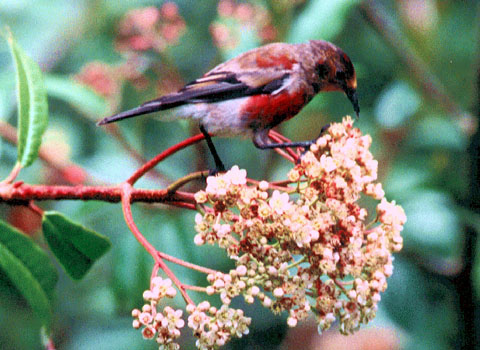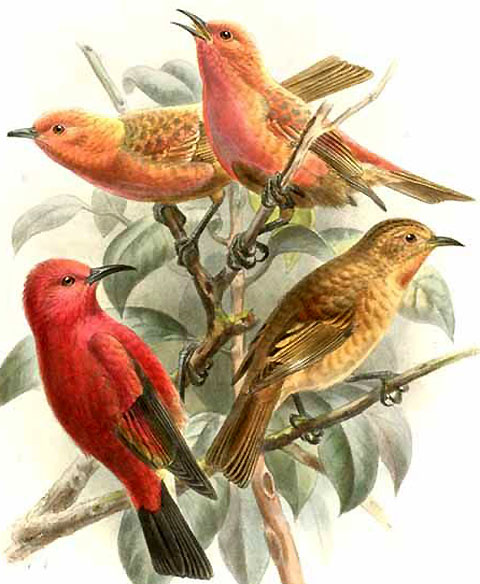Birds and Plants of Kauai:
Apapane
by Linda Pascatore on 13 May 2007
The Apapane, a Hawaiian honeycreeper, is one of the most common native forest birds of Hawaii. This small red bird is commonly seen drinking the nectar of the ohia-lehua blossoms. It is known for it’s beautiful and varied calls and songs. Ancient Hawaiians often used Apapane feathers for feather capes and to decorate helmets.
The Apapane, or Himatione sanguinea, is about 5 inches long. The male is bright red with a white abdomen and undertail, and black wings, tail and legs. The female is more neutral in color, with a hint of red on shoulders and throat.
The Apapane bill is black and curved and the tongue is tube-like with a fringed tip to facilitate drinking flower nectar. The bird makes a distinctive whirring sound when flying. Hawaiian honeycreepers are believed to have descended from a species of finch that found its way to the islands, possibly 3 to 4 million years ago.

Apapane male
The bird is found in upland forests on all of the main islands, but is more common on Kauai, Hawaii, and Maui. The honeycreeper breeds during the winter, and usually nests in the Ohia-Lehua tree. The breeding pair makes a cup shaped nest from grass, twigs, and lichen. The female lays and incubates 2-4 eggs, while the male feeds both the brooding female and the young.
The Apapane eats mostly nectar, with occasional insects or spiders. The nectar of the flowering Ohia tree makes up the bulk of it’s diet, although it also feeds on flowering koa, mamane, pine and eucalyptus. The birds are very social, and gather together to fly in large flocks, searching for blooming Ohia trees.

Apapane juvenile
Apapane are susceptible to mosquito borne avian disease, which is why they are found in high elevation forests, over 3300 feet elevation, where it is too cold for mosquitos. The mosquito was not endemic to the Hawaiian islands, but brought here as stowaways on European and American ships. Thus the native birds had not evolved any natural immunity to these insects.
On Kauai, Apapane are commonly seen in Kokee State Park wherever the Ohia Lehua trees are found, and they have often been photographed near the Kalalau Lookout.
|




